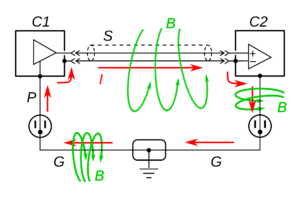A Brief Introduction
 Most workers already know that proper grounding is a fundamental safety precaution for all kinds of electrical equipment. However, it’s less well known that while grounding can prevent and resolve many safety and power issues, improper grounding can create problems in data logging, data acquisition, and measurement and control systems.
Most workers already know that proper grounding is a fundamental safety precaution for all kinds of electrical equipment. However, it’s less well known that while grounding can prevent and resolve many safety and power issues, improper grounding can create problems in data logging, data acquisition, and measurement and control systems.
One of the most common problems is known as ground loop feedback–an electrical phenomenon often resulting when different electrical circuits within a system and its peripherals have different connections or paths back to earth ground. Furthermore, this can also be a seasonal issue where problems come and go based on climatic conditions. The Application Specialists at CAS DataLoggers have put together this brief introduction on the subject.
Ground Loop Feedback Explained
Ground loop feedback is a frequently encountered wiring issue arising when two or more connected electrical devices have more than one path to earth ground. Together, the separate paths form a loop. Electrical and magnetic fields that flow through the loop can generate unintended currents and voltages. Or, the ground points of the different devices may not be at the same potential voltage due to current and resistance in the ground path. The net effect is that while it is believed that the devices have the same ground reference point in fact they don’t and this difference can appear as a simple offset in measured values or as signal noise that corrupts the devices’ normal operation.
Induced currents in ground loops from mains AC power cause buzzing or humming sounds. In video, they create onscreen stripes, while computer and networking users may experience shutdowns or communication gaps. Engineers and technicians also notice offsets or noise in their data. Neglecting ground loops disrupts operations for businesses, often overlooked during installations.
Computers, data loggers, and data acquisition/control systems are normally connected to the ground through their AC power supply and the ground pin on the plug that goes into the wall outlet that shares the ground wire in common building wiring. These devices may also be connected to each other by data communications cables. Ethernet cables are pretty good at maintaining ground isolation but serial communications cables, RS232 for example, have their own ground conductor. Now if the computer is plugged into an outlet in one area of the building and an RS232 device it is connected to is in a different area of the building it can create a multi-path connection and a ground loop.
A computer can control manufacturing equipment but may need a different power source than the machine. Each breaker panel has its own ground stakes, ideally with no resistance. However, resistance can occur, causing erratic operation or shutdown of the computer and the equipment it controls. Ground loops can impact low-level measurements due to cabling. Shielded cables are usually used for sensitive measurements to protect the signal from electromagnetic interference. The shield should be connected to the ground at only one end to collect interference and keep the signal clean. If connected at both ends, it creates a potential ground loop, allowing interference to couple to the measured signal as electrical noise.

Figure 1. Changing the magnetic field causes a current in the shield and the low side of the signal conductor, inducing a voltage offset error in measurement.
Ground loop feedback increasingly threatens industrial processes due to the sensitivity of newer electrical equipment. For instance, external analog voltage signals can control recent variable frequency AC drives. If these drives encounter noise on the control signal, they may experience errors or failure.
In the upcoming part 2, find out how exactly to diagnose ground loop feedback as well as five steps to reduce and prevent ground loops from occurring.


Leave a Reply
You must be logged in to post a comment.